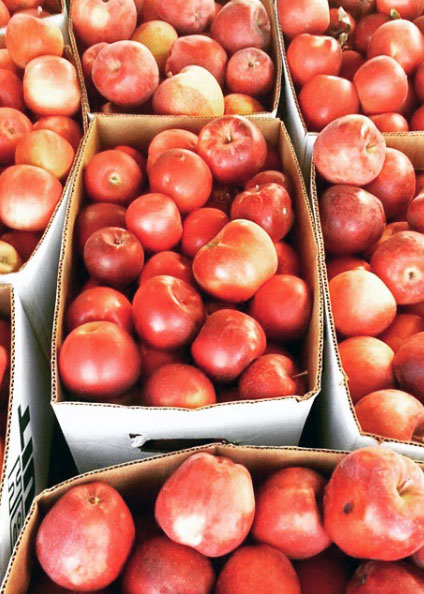You’re accessing archived content
This is archived content from the UIT website. Information may be outdated, and links may no longer function. Please contact stratcomm@it.utah.edu if you have any questions about archived content.
Getting to the core of tinkerer Russ Knight
 Scribbled in a corner of Russ Knight’s whiteboard is, “When all you have is a hammer,
every problem looks like a nail,” paraphrasing psychologist Abraham Maslow.
Scribbled in a corner of Russ Knight’s whiteboard is, “When all you have is a hammer,
every problem looks like a nail,” paraphrasing psychologist Abraham Maslow.
It’s fitting for Knight, UIT Asset and Inventory Manager. The man comes from a long line of tinkerers.
“We have a mind for engineering; it’s in the genes,” he said.
Back when he lived in Connecticut, one of Knight’s earliest projects was building a cider press with his dad, Lee. The kit came from Jaffrey, New Hampshire. Apple cider is, after all, the Granite State's official beverage.
It arrived in a box with all the necessary hardware, some pieces of maple, and a set of instructions. It wasn’t long before Lee went off-script, opting for rock maple, which is extremely dense and when rubbed with mineral oil, impervious to water. It was also “insanely heavy,” Knight said.
Every subsequent October, the family would host a fall harvest festival. Besides the new press, the party featured a big bonfire and tractor-powered hay rides through the woods. Kids would get dizzy on a merry-go-round while adults dished out stews and chili, all washed down with fresh-pressed cider.
Fast forward a few decades. Knight is married with three little girls, living in a hillside cabin in Midway, Utah, south of Park City. One day he gets nostalgic for the old cider press, and decides to build an heirloom-quality press of his own, with advice from his older brother, also named Lee.
 He starts with a 16/4 (four-inch thick) slab that measures 16 feet long by 8 inches
wide overall. He mills it down and consults his cut list, creating a set number of
differently sized and shaped pieces. These he will plane down (flatten and smooth
out) before making precise cuts at junction points.
He starts with a 16/4 (four-inch thick) slab that measures 16 feet long by 8 inches
wide overall. He mills it down and consults his cut list, creating a set number of
differently sized and shaped pieces. These he will plane down (flatten and smooth
out) before making precise cuts at junction points.
Knight doesn’t want to spill too many proprietary secrets, but the key components to a press are a grinder with hand-crank, netted bag to collect the pulp, slatted barrel where the pressing takes place, hand-screw connected to a press board, slotted drain, catch basin and a bucket to collect the juice.
Knight has since built several presses, improving on the design each time. Helping him are nephews Clayton Stark and Jacob Whitlow. Whitlow, a Film & Media Arts student at the U with an engineering emphasis, contributed a modification created in a digital fabrication course.
You’d be hard pressed (pun intended) to meet someone with more zeal for the art of cider presses than Knight.
“It’s not about how good is the juice. It’s what went into the rig that pressed it, and if I can use an old part, to me, it creates that ambience even more,” he said.
The next iteration will be forging and casting his own metal parts. Outside of some bolts and wing nuts (which he uses in his grinder), his new presses will be almost all-original construction.
 Besides gratifying his passion for building and machining, the presses give him an
excuse to recreate the fall harvest parties. Each autumn, people come over with 10
to 20 pounds of apples each, which he supplements with 80 more pounds so there’s enough
cider for guests to take home.
Besides gratifying his passion for building and machining, the presses give him an
excuse to recreate the fall harvest parties. Each autumn, people come over with 10
to 20 pounds of apples each, which he supplements with 80 more pounds so there’s enough
cider for guests to take home.
“I like the idea that I’m sharing something of my childhood with my friends and my kids,” he said.
For Knight, what goes into an object transcends the act of building. Old machine parts, he believes, should never be buried or left to rust, but repurposed or at minimum, appreciated as pieces of art.
“I truly believe there’s life in the material I use to build,” he said. “It transcends time. It’s a legacy thing.”
Sadly, this past January, Knight’s father passed away.
Knight’s memories of that first cider press are even more poignant, but their shared love of tinkering lives on in Knight’s nephews and perhaps one day, his daughters, too.
A legacy thing, indeed.
Node 4
Our monthly newsletter includes news from UIT and other campus/ University of Utah Health IT organizations, features about UIT employees, IT governance news, and various announcements and updates.
